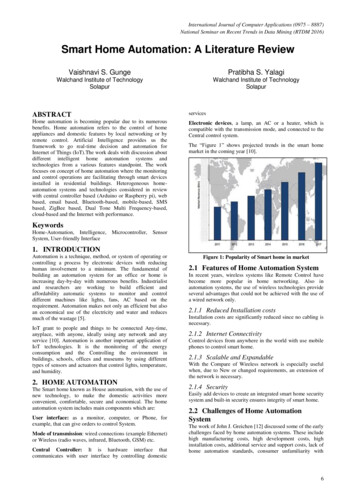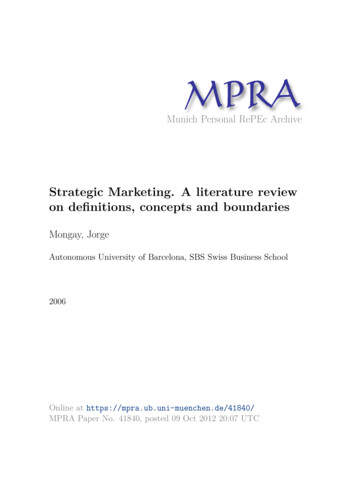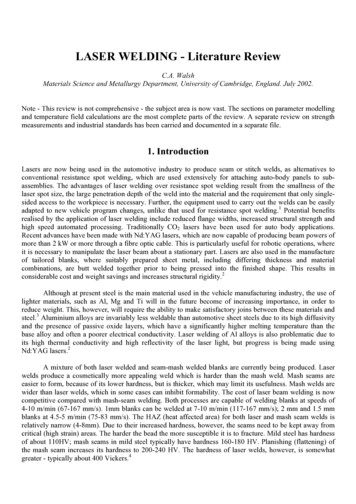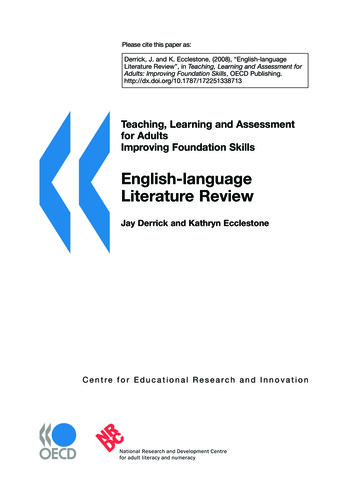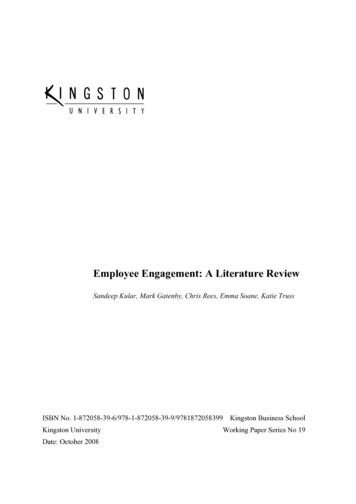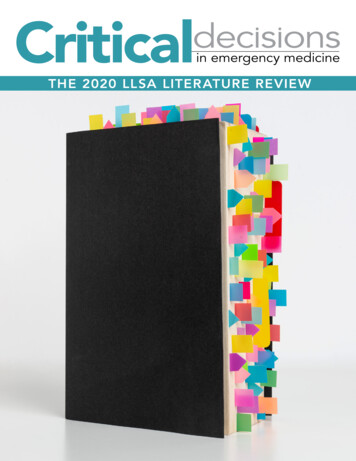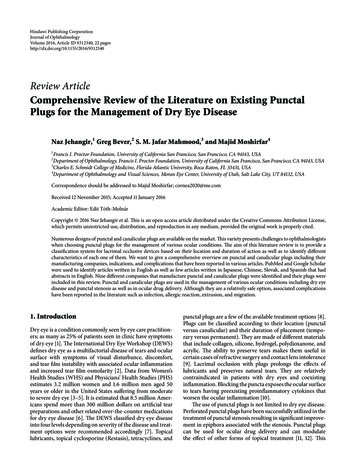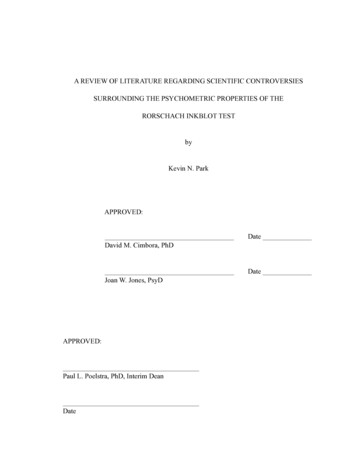
Transcription
A REVIEW OF LITERATURE REGARDING SCIENTIFIC CONTROVERSIESSURROUNDING THE PSYCHOMETRIC PROPERTIES OF THERORSCHACH INKBLOT TESTbyKevin N. ParkAPPROVED:David M. Cimbora, PhDDateJoan W. Jones, PsyDDateAPPROVED:Paul L. Poelstra, PhD, Interim DeanDate
A REVIEW OF LITERATURE REGARDING SCIENTIFIC CONTROVERSIESSURROUNDING THE PSYCHOMETRIC PROPERTIES OF THERORSCHACH INKBLOT TESTA Doctoral Research PaperPresented tothe Faculty of the Rosemead School of PsychologyBiola UniversityIn Partial Fulfillmentof the Requirements for the DegreeDoctor of PsychologybyKevin N. ParkMay 2009
Copyright 2009 by Kevin N. Park
ABSTRACTA REVIEW OF LITERATURE REGARDING SCIENTIFIC CONTROVERSIESSURROUNDING THE PSYCHOMETRIC PROPERTIES OF THERORSCHACH INKBLOT TESTbyKevin N. ParkThe Rorschach Inkblot Test has been the focus of intense controversy,significantly impacting clinicians who currently rely on Exner’s Comprehensive System(CS; Exner, 2003) in clinical and forensic settings. This paper evaluates recent empiricalCS research to determine whether or not it reveals lack of scientific merit as someskeptics have claimed. Relevant psychometric properties of the Rorschach are identifiedand evaluated to determine whether they meet accepted standards applicable to otherpsychological instruments in current use. Past reviews and recent empirical researchpublished from 1998 to 2008 are critically reviewed.Specific properties under investigation in this controversy are validity(incremental, convergent, and construct), reliability (interrater, test-retest), standardizedprocedures, and normative data. This literature review critiques a sample of recentempirical research related to each of these categories, and the findings generally revealaverage to excellent psychometric properties. Trained and experienced examiners can useiii
the Rorschach with confidence in its scientific legitimacy, and charges that call for amoratorium on the Rorschach due to insufficient empirical backing are rejected.The Rorschach should continue to be scrutinized in peer-reviewed journals usingcriteria similar to those applied to other psychological instruments. The legitimacy andutility of the Rorschach should be based on unbiased empirical evidence, and resultsshould be communicated clearly to all consumers of Rorschach data in clinical,educational, and forensic settings. Areas of future research are discussed under theassumption that weaknesses in certain aspects of the Rorschach do not equate toillegitimacy of the CS as a whole.iv
TABLE OF CONTENTSPAGELIST OF TABLES. viDOCTORAL RESEARCH PAPERIntroduction. 1Chapter One: The Rorschach Inkblot Test. 7Chapter Two: Review of the Literature. 11Psychometric Properties of the CS. 11Validity . 11Incremental validity . 12Convergent validity .16Construct validity .21Reliability . 31Interrater reliability . 32Test-retest reliability . 40Standardized Procedures. 46Normative Data. 52Chapter Three: Summary and Conclusions . 59Suggestions for Further Research. 62Concluding Remarks.63REFERENCES.66VITA. 71v
LIST OF TABLESPAGETable 1. A Sample of Psychological and Medical Test Validity. 8Table 2. Mean Scores of P, Sum C’, DEPI, and CDI. 57vi
A REVIEW OF LITERATURE REGARDING SCIENTIFIC CONTROVERSIESSURROUNDING THE PSYCHOMETRIC PROPERTIES OF THERORSCHACH INKBLOT TESTIntroductionHermann Rorschach first introduced the Rorschach Inkblot Test to thepsychological assessment community in 1921 with the publication of Psychodiagnostik(Rorschach, 1921). The Rorschach rapidly increased in popularity, and leading figures inthe field were inspired by the Rorschach’s potential as a unique approach tounderstanding personality. Early enthusiasm for its potential utility was eventually met bya demand for empirical validation, inspiring efforts to harmonize several disjointedRorschach interpretive systems (Exner, 2003).The Rorschach rose in popularity due in part to its association withpsychoanalysis. However, as its popularity grew, so did fundamental disagreements onhow the data should be interpreted. Some saw Rorschach responses as products ofperception, which were indicators of how a person structures and organizes the externalworld. Others, following a more psychoanalytic approach, saw the responses as“projective productions or symbolic manifestations of a person’s internal world” (Plake& Impara, 2001, p. 1034). Many leading researchers were increasingly convinced that theformer approach held the most potential for empirical validation and acceptance in thescientific community.
2By 1936, five different Rorschach interpretive systems were in use, and eachsystem competed for validation for the next 32 years until 1968. After years of intensedispute between proponents of the various systems, the Rorschach Research Foundationwas established to develop one system that could be subjected to empirical scrutiny. Forabout the next six years, members of the foundation focused on integrating the bestaspects of all the systems, resulting in the introduction of John Exner’s ComprehensiveSystem in 1974 (Exner, 2003). Acceptance of the CS in the scientific communitygradually widened based on the growing body of validation data and promising directionsfor further research (Exner).Despite these advances, the association between the Rorschach andpsychoanalysis persisted, and those who objected to “Freudian” theoretical underpinningswere also highly skeptical of any attempts at scientific validation of a projective test(Plake & Impara, 2001, p. 1034). A “culture clash,” which is still evident in the currentcontroversy, escalated in the scientific community with the introduction of the MinnesotaMultiphasic Personality Inventory (MMPI; p. 1034). While the MMPI grew to berepresentative of the psychometric approach to psychology, the Rorschach entered thepublic’s imagination through television and movies as the Freudian approach. TheRorschach’s rise in popularity appeared to overshadow its scientific credentials whichsome still consider severely lacking. Nevertheless, since 1974 the CS has become themost widely researched and most commonly taught system for administering, scoring,and interpreting Rorschach responses (Guarnaccia, Dill, Sabatino, & Southwick, 2001).
3Exner’s scientific advances on the CS were commended in 1998 by the AmericanPsychological Association (APA) Board of Professional Affairs (BPA).1As is expected in the realm of normal scientific debate, researchers, clinicians,and educators have critiqued the Rorschach as they would any other instrument. Suchscrutiny is intended to reveal strengths and weaknesses and encourage improvement infuture research design. Rorschach research had generally progressed in this manner untilit was openly challenged in 1995. At this time, articles opposing the Rorschach startedappearing in prominent assessment journals (Journal of Personality Assessment,Assessment, and Psychological Assessment) as well as several specialty publications(Journal of Clinical Psychology, Journal of Forensic Psychology, and Psychology, PublicPolicy, and Law). The growing controversy drew the attention of researchers,practitioners, and academics, which created renewed skepticism over the Rorschach’slegitimacy. Controversy and scientific scrutiny are nothing new to the Rorschach, andindeed such scrutiny provided the impetus to develop the CS in the first place. However,despite attempts to advance the CS based on empirical research, those associated with theRorschach have been defending the legitimacy of the test and even their professionalqualifications ever since the current controversy surfaced (Hilsenroth & Stricker, 2004).A small cadre of opponents has been quite open about their opinion of theRorschach as a “shoddy” test with an empirical foundation based on “junkscience” (Hunsley & Bailey, 2001; Lilienfeld, Wood, & Garb, 2000). They have1The APA BPA bestowed on John Exner its Award for Distinguished ProfessionalContributions to Knowledge (Weiner, Speilberger, & Abeles, 2002) for his work on theCS.
4described the research methods used by CS researchers as “pseudoscience” (Lohr,Fowler, & Lilienfeld, 2002, p. 8), and they have concluded that Rorschach proponents aresimply refusing to face the facts (Wood, Lilienfeld, Nezworski, & Garb, 2001) thatclearly reveal the Rorschach’s lack of scientific credibility. Lohr et al. assert thatRorschach researchers have avoided the scientific credibility issue by relying on theRorschach’s popularity and making “extravagant claims” that the Rorschach“ possesses special, even remarkable capacities” (p. 6). Rorschach proponents deny thisclaim and point out that these comments were taken directly from the text of the citationby the APA BPA when it honored John Exner’s work on the CS in 1998 (Weiner,Speilberger, & Abeles, 2002).In response to these charges, Rorschach proponents have attempted to conductempirical research under the scrutiny of peers, opponents, and unbiased sources.Additionally, they have conducted multiple meta-analyses (Meyer, 2000, 2001; Meyer etal., 2001; Rosenthal, Hiller, Bornstein, Berry, & Brunell-Neuleib, 2001; Viglione &Hilsenroth, 2001) on the psychometric properties of the Rorschach in an attempt torespond to attacks with scientific evidence. This concerted effort by Rorschachproponents to exemplify the scientific method appears to have had little or no effect onopponents (Weiner et al., 2002), who have concluded that there is a “ half-century oflargely negative scientific evidence” against the Rorschach and a “ wealth of scientificevidence that the test is of questionable utility for real-world decision making” (Wood,Nezworski, Lilienfeld, & Garb, 2003, p. 1). Lohr et al. (2002), speaking on behalf of theopposition to the Rorschach, have appealed to the APA and other professional
5organizations to “ impose stiff sanctions, including expulsion if necessary, onpractitioners who routinely use therapeutic and assessment practices that are devoid ofscientific support” (p. 8).In addition to dismissing the research supporting the Rorschach, opponentsdeclare that it is not a legitimate psychological instrument and should no longer be taughtor administered. They characterize it as an unscientific mind-reading technique in theirrecent book, What’s Wrong with the Rorschach? Science Confronts the ControversialInkblot Test (Wood et al., 2003). In the introduction, they state:[M]ost psychologists in clinical practice have treasured the test as one oftheir most precious tools. And . . . many of their respected scientificcolleagues have been trying to persuade them that the test is well-nighworthless, a pseudoscientific modern variant on tea leaf reading and Tarotcards. (p.1)Proponents of the Rorschach assert that only those with adequate training and clinicalexperience with the CS understand its true nature as a complex and nuanced behavioralobservation methodology. They staunchly defend the psychometric soundness of the CS;however, they readily admit that it is difficult to administer, score, and interpretaccurately (Archer, 1999; Exner, 2003). Highlighting these Rorschach weaknesses,opponents characterize Rorschach scoring issues as complex, vague, and unscientific.Wood et al. state:[T]he test bears a charming resemblance to a party game. A person isshown ten inkblots and asked, “What might this be?” Like swirlingimages in a crystal ball, the ambiguous blots tell a different story to everyperson who looks upon them. There are butterflies and bats, diaphanousdresses and bow ties, monkeys, monsters, and mountain-climbing bears.When scored and interpreted by an expert, people’s responses to the blots
6are said to provide a full and penetrating portrait of their personalities.(p. 1)This sardonic portrayal of the process of Rorschach administration, scoring, andinterpretation appears consistent with the perception of the Rorschach in popular culture.In an attempt to separate popular perception from scientific discourse, this literaturereview attempts to focus primarily on CS empirical data and avoid philosophicalarguments about the Rorschach or projective assessment in general.Regardless of politics and ideology of those involved in this controversy, the factremains that the Rorschach is currently being utilized extensively in graduate programs,clinical practices, psychiatric hospitals, and courtrooms (Bornstein, 2001). It is importantto emphasize that the controversy reveals markedly opposing views of the same extantliterature. For well over a decade, proponents have dedicated considerable resources inproducing empirical data as a rejoinder to ongoing attacks. Opponents also have investedconsiderable resources, and it appears now that the conflict is at an impasse. Even so,there does not appear to be any argument on either side over the need for expedientresolution in the best interest of patients, clients, clinicians, and educators.The relevancy of the current controversy extends well beyond the academic realmto those who use the Rorschach and depend on reliable data to back up their decisionmaking. Consumers of Rorschach data are left with a poignant real-world question raisedby this controversy (Meyer et al., 2001): Does the Rorschach demonstrate acceptablepsychometric properties according to the same scientific standards applied to otherinstruments? This review hypothesizes that this question can be addressed by analysis of
7a broad sample of recent empirical CS research. Past research and meta-analyses arerelevant in this review insofar as they have contributed to the most recent research on theCS.This paper reviews a sample of recent empirical articles relevant to the followingpsychometric properties commonly discussed by both sides of the controversy: (a)validity (incremental, convergent, and construct) (b) reliability (interrater and test-retest)(c) standardized procedures, and (d) normative data (Weiner et al., 2002). This ratherbroad approach is in response to the broad nature of the attacks on the CS as having littleor no scientific merit (Wood et al., 2001). These psychometric properties are evaluated todetermine whether they fall within currently accepted standards for psychologicalinstruments. Failure of empirical research to meet minimum standards in these categorieswould warrant concern over the fundamental psychometric soundness of the Rorschach.Past reviews and recent empirical research published from 1998 to 2008 are criticallyreviewed. Although CS variables are the main focus of critique, several experimentalnon-CS variables are discussed only as they relate to the psychometric propertiesexamined in this report. Suggestions for further research are also explored.Chapter One: The Rorschach Inkblot TestIn order to determine the standard to which the Rorschach should be held, it mustfirst be determined if psychological assessment instruments in general meet standardsuniversally recognized throughout all fields of scientific research. The Rorschach shouldbe at least as comparable to other widely used psychological tests, and these same
8psychological tests should be comparable to tests used in other fields of study. TheAmerican Psychological Association’s Board of Professional Affairs appointed aPsychological Assessment Work Group (PAWG) to objectively evaluate efficacy ofpsychological assessment compared to instruments used in other fields of research. Thegroup conducted an exhaustive meta-analysis of 125 other meta-analyses on test validity,and they reached four conclusions: (a) psychological tests have acceptable validity,(b) psychological tests have validity similar to medical tests, (c) psychological tests haveempirically proven clinical utility, and (d) psychological tests offer significantimprovement over interview alone (Meyer et al., 2001). They concluded,“ psychological test validity is strong and compelling” and “ comparable to medicaltest validity” (p. 128). A few specific correlations they listed for comparison purposes areshown in Table 1.Table 1A Sample of Psychological and Medical Test Validity:(a) Weight and height for U.S. adults (.44)(b) MMPI validity scales and detection of malingered psychopathology (.44)(c) WAIS IQ and obtained level of education (.44)(d) Rorschach PRS scores and subsequent psychotherapy outcome (.44)(e) Viagra and improved male sexual functioning (.38)(f) Rorschach dependency scores and dependent behavior (.37)(g) MMPI scale scores and ability to detect depressive or psychotic disorders (.37)
9(h) Screening mammogram results and detection of breast cancer within 1 year (.32)(i) Sleeping pills and short-term improvement in chronic insomnia (.30)(Meyer et al., 2001, p. 128).These results have been supported by similar studies by Viglione (1999), Viglione andHilsenroth (2001), and Weiner (2001b). The wide scope of these studies suggests that as apsychological test, the Rorschach should be able to meet minimally acceptable standardsas compared to instruments reviewed in the PAWG study.The Rorschach is essentially a behavior observation methodology that relies onthe application of a complex coding system to samples of verbal behavior. It encompassesnomothetic trait and idiographic behavior approaches to personality assessment, yieldinga plethora of behavioral observation data. Individual codes are applied to target behaviors(i.e., key words) within each response, and then they are tabulated, summed, andcombined to form interpretive indexes. Organization of response-level verbal behaviors(e.g., location, developmental quality, determinants) facilitates the process of coding andinterpretation (Acklin, McDowell, Verschell, & Chan, 2000). The Rorschach is not adiagnostic test. It is intended to identify personality characteristics of the individual, andits utility derives from the relevance of these characteristics to “decision-making inclinical, forensic, health care, educational, and organizational settings” (Weiner et al.,2002, p. 6).For the respondent, the Rorschach is an unstructured task of perception andverbalization of perception, characterized by the following: (a) test stimuli have no face
10validity, (b) the testing administratio
a review of literature regarding scientific controversies surrounding the psychometric properties of the rorschach inkblot test by kevin n. park


